Exploring the Spatio-Temporal Trends of Geomorphological Incidents Induced by Precipitation on Chinese Highways
Abstract
:1. Introduction
2. Data and Methods
2.1. Data Sources
2.2. Research Methods
2.2.1. Regional Division Standards
2.2.2. Rainfall Grading Standards
2.2.3. County-Level Incident Proportion
2.2.4. Probability of Precipitation-Induced Incidents
2.2.5. Antecedent Effective Precipitation
3. Feature Analysis of Highway Geomorphological Incident Events
3.1. Spatial Distribution Characteristics
3.1.1. Regional Distribution Features
3.1.2. Roads with Frequent Occurrences
3.2. Temporal Distribution Characteristics
3.2.1. Annual Variation Features
3.2.2. Monthly Variation Features
3.2.3. Characteristics of Highway Geomorphological Incident Blockages
4. Spatiotemporal Characteristics of Precipitation-Induced Conditions
4.1. Probability of Precipitation-Induced Incidents at Various Intensities
4.2. Hourly Precipitation Characteristics for the Preceding 24 h
4.3. Cumulative Precipitation Characteristics for the Preceding 24 h
4.4. Daily Precipitation Characteristics for the Preceding 15 Days
4.5. Effective Precipitation Characteristics for the Preceding 15 Days
4.6. Characteristics of the Maximum Continuous Rainfall Days for the Preceding 15 Days
5. Conclusions and Future Research
5.1. Feature Analysis of Highway Geomorphological Incident Events
5.2. Spatiotemporal Characteristics of Precipitation-Induced Conditions
5.3. Limitations and Future Research
Author Contributions
Funding
Institutional Review Board Statement
Informed Consent Statement
Data Availability Statement
Conflicts of Interest
References
- Hong, J.; Chu, Z.; Wang, Q. Transport infrastructure and regional economic growth: Evidence from China. Transportation 2011, 38, 737–752. [Google Scholar] [CrossRef]
- China Ministry of Transport. 2022 Statistical Bulletin on the Development of China’s Transportation Industry. 2023. Available online: https://xxgk.mot.gov.cn/2020/jigou/zhghs/202306/t20230615_3847023.html (accessed on 1 July 2023).
- Yang, C.; Zhang, H.; Li, X.; He, Z.; Li, J. Analysis of spatial and temporal characteristics of major natural incidents in China from 2008 to 2021 based on mining news database. Nat. Hazards 2023, 118, 1881–1916. [Google Scholar] [CrossRef]
- Huang, Y.; Li, L.; Xu, C.; Cheng, J.; Xu, X.; Zheng, T.; Zhang, X. Spatiotemporal distribution patterns of deadly geohazard events in China, 2013–2019. Nat. Hazards Res. 2022, 2, 316–324. [Google Scholar] [CrossRef]
- Wu, L.; Ma, D.; Li, J. Assessment of the Regional Vulnerability to Natural Disasters in China Based on DEA Model. Sustainability 2023, 15, 10936. [Google Scholar] [CrossRef]
- Chen, W.; Zhong, C.; Qin, X.; Wang, L. Geological Disaster: An overview. In Intelligent Interpretation for Geological Disasters; Springer: Singapore, 2023. [Google Scholar] [CrossRef]
- Turner, A.K. Social and environmental impacts of landslides. Innov. Infrastruct. Solut. 2018, 3, 70. [Google Scholar] [CrossRef]
- Lin, C.-Y.; Lai, Y.-C.; Wu, S.-W.; Mo, F.-C.; Lin, C.-Y. Assessment of potential sediment incidents and resilience management of mountain roads using environmental indicators. Nat. Hazards 2022, 111, 1951–1975. [Google Scholar] [CrossRef]
- Amatya, P.; Kirschbaum, D.; Stanley, T. Use of Very High-Resolution Optical Data for Landslide Mapping and Susceptibility Analysis along the Karnali Highway, Nepal. Remote. Sens. 2019, 11, 2284. [Google Scholar] [CrossRef]
- Bi, H.; Nie, L.; Zeng, C.; Fan, C.; Zhou, T.; Liu, X. Geological hazard susceptibility evaluation in Wenchuan area based on three models of multivariate instability index analysis. Chin. J. Geol. Hazard Control. 2022, 33, 123–131. (In Chinese) [Google Scholar] [CrossRef]
- Chen, C.; Sun, F. Flood damage assessments based on entropy weight-grey relational analyses. J. Tsinghua Univ. Sci. Technol. 2022, 62, 1067–1073. (In Chinese) [Google Scholar] [CrossRef]
- Guo, J.; Huang, H.; Li, G. Basic characteristics and meteorological risk assessment of highway geological hazard in Sichuan province. Plateau Mt. Meteorol. Res. 2017, 37, 82–86. [Google Scholar] [CrossRef]
- Kim, H.-S.; Chung, C.-K.; Kim, S.-R.; Kim, K.-S. A GIS-Based framework for real-time debris-flow hazard assessment for expressways in Korea. Int. J. Disaster Risk Sci. 2016, 7, 293–311. [Google Scholar] [CrossRef]
- Yang, H.; Zhao, Y.; Cheng, Q. Geohazards regionalization along highways in Shandong province, China. Geomat. Nat. Hazards Risk 2020, 11, 1760–1781. [Google Scholar] [CrossRef]
- Yang, H.-Z.; Dong, J.-Y.; Guo, X.-L. Geohazards and risk assessment along highway in Sichuan Province, China. J. Mt. Sci. 2023, 20, 1695–1711. [Google Scholar] [CrossRef]
- Silveira, L.R.C.; Lana, M.S.; dos Santos, T.B. A Quantitative Rockfall Risk Analysis System for Highway Rock Slopes. Geotech. Geol. Eng. 2023, 42, 1131–1152. [Google Scholar] [CrossRef]
- Ansari, M.K.; Ahmad, M.; Singh, R.; Singh, T.N. Rockfall hazard rating system along SH-72: A case study of Poladpur-Mahabaleshwar road (Western India), Maharashtra, India. Geomat. Nat. Hazards Risk 2015, 7, 649–666. [Google Scholar] [CrossRef]
- Budetta, P.; De Luca, C.; Nappi, M. Quantitative rockfall risk assessment for an important road by means of the rockfall risk management (RO.MA.) method. Bull. Eng. Geol. Environ. 2015, 75, 1377–1397. [Google Scholar] [CrossRef]
- Zhang, Y.; Huang, C.; Li, M. Spatio-temporal evolution characteristics of typical debris flow sources after an earthquake. Landslides 2022, 19, 2263–2275. [Google Scholar] [CrossRef]
- Li, Y.; Zou, Q.; Hao, J.; Su, L. Risk Assessment of Debris Flows Along the Karakoram Highway (Kashgar-Khunjerab Section) in the Context of Climate Change. Int. J. Disaster Risk Sci. 2023, 14, 586–599. [Google Scholar] [CrossRef]
- Ali, S.; Haider, R.; Abbas, W.; Basharat, M.; Reicherter, K. Empirical assessment of rockfall and debris flow risk along the Karakoram Highway, Pakistan. Nat. Hazards 2021, 106, 2437–2460. [Google Scholar] [CrossRef]
- Zhang, Y.; Ayyub, B.M.; Gong, W.; Tang, H. Risk assessment of roadway networks exposed to landslides in mountainous regions—A case study in Fengjie County, China. Landslides 2023, 20, 1419–1431. [Google Scholar] [CrossRef]
- Jaiswal, P.; van Westen, C.J.; Jetten, V. Quantitative assessment of direct and indirect landslide risk along transportation lines in southern India. Nat. Hazards Earth Syst. Sci. 2010, 10, 1253–1267. [Google Scholar] [CrossRef]
- Zhou, M.; Yuan, M.; Yang, G.; Mei, G. Risk analysis of road networks under the influence of landslides by considering landslide susceptibility and road vulnerability: A case study. Nat. Hazards Res. 2023, 9, 1–35. [Google Scholar] [CrossRef]
- Shao, L. Geomorphological incident prevention and control and resource protection in mineral resource exploitation region. Int. J. Low-Carbon Technol. 2019, 14, 142–146. [Google Scholar] [CrossRef]
- Yu, P.; Dong, J.; Hao, H.; Xie, Y.; Zhang, H.; Wang, J.; Zhu, C.; Guan, Y.; Yu, H. Risk Assessment and Prevention Planning for Collapse Geological Hazards Considering Extreme Rainfall—A Case Study of Laoshan District in Eastern China. Land 2023, 12, 1558. [Google Scholar] [CrossRef]
- Jia, L.; Yang, S.; Wang, W.; Zhang, X. Impact analysis of highways in China under future extreme precipitation. Nat. Hazards 2021, 110, 1097–1113. [Google Scholar] [CrossRef]
- Liu, K.; Wang, M.; Cao, Y.; Zhu, W.; Wu, J.; Yan, X. A Comprehensive Risk Analysis of Transportation Networks Affected by Rainfall-Induced Multihazards. Risk Anal. 2018, 38, 1618–1633. [Google Scholar] [CrossRef] [PubMed]
- Pregnolato, M.; Alistair, F.; Richard, D. Analysis of the risk of transport infrastructure disruption from extreme rainfall. In Proceedings of the 12th International Conference on Applications of Statistics and Probability in Civil Engineering, Vancouver, BC, Canada, 12–15 July 2015. [Google Scholar] [CrossRef]
- Yang, S.; Ye, J.; Zhang, X.; Liu, H. Study of the impact of rainfall on freeway traffic flow in Southeast China. Int. J. Crit. Infrastruct. 2012, 8, 230–241. [Google Scholar] [CrossRef]
- Yang, S.; Yin, G.; Shi, X.; Liu, H.; Zou, Y. Modeling the adverse impact of rainstorms on a regional transport network. Int. J. Disaster Risk Sci. 2016, 7, 77–87. [Google Scholar] [CrossRef]
- Zhang, S.; Wang, Y.; Jia, B.; Shangming, Z. Spatial-temporal changes and influencing factors of geologic incidents from 2005 to 2016 in China. J. Geo. Inf. Sci. 2017, 19, 1567–1574. [Google Scholar] [CrossRef]
- Bi, X.; Fan, Q.; He, L.; Zhang, C.; Diao, Y.; Han, Y. Analysis and Evaluation of Extreme Rainfall Trends and Geological Hazards Risk in the Lower Jinshajiang River. Appl. Sci. 2023, 13, 4021. [Google Scholar] [CrossRef]
- Shen, D.; Guo, J.; Chen, J. Risk assessment of geological hazards in Dingxi region of Gansu Province. Chin. J. Geol. Hazard Control. 2021, 32, 134–142. [Google Scholar] [CrossRef]
- Kirschbaum, D.; Adler, R.; Adler, D.; Peters-Lidard, C.; Huffman, G. Global Distribution of Extreme Precipitation and High-Impact Landslides in 2010 Relative to Previous Years. J. Hydrometeorol. 2012, 13, 1536–1551. [Google Scholar] [CrossRef]
- Kirschbaum, D.; Kapnick, S.B.; Stanley, T.; Pascale, S. Changes in Extreme Precipitation and Landslides Over High Mountain Asia. Geophys. Res. Lett. 2019, 47, 4. [Google Scholar] [CrossRef]
- Lausier, A.M.; Jain, S. Overlooked Trends in Observed Global Annual Precipitation Reveal Underestimated Risks. Sci. Rep. 2018, 8, 16746. [Google Scholar] [CrossRef] [PubMed]
- Chang, S.-K.; Lee, D.-H.; Wu, J.-H.; Juang, C.H. Rainfall-based criteria for assessing slump rate of mountainous highway slopes: A case study of slopes along Highway 18 in Alishan, Taiwan. Eng. Geol. 2011, 118, 63–74. [Google Scholar] [CrossRef]
- Wang, Z.; Tian, H.; Di, J.; Xu, F. Research on the tempo-spatial characteristics of road damage induced by precipitation. J. Meteorol. Environ. 2018, 34, 98–104. (In Chinese) [Google Scholar]
- Tian, H.; Wang, Z.; Dai, Z.; Li, W. Research on Relationship Between Highway Traffic Blocking Induced by Waterlogging and Precipitation. Meteorol. Mon. 2018, 44, 684–691. (In Chinese) [Google Scholar]
- Crozier, M.J.; Eyles, R.J. Assessing the probability of rapid mass movement. In Proceedings of the 3rd Australia–New Zealand Conference on Geomechanics, Wellington, New Zealand, 12–16 May 1980; Institution of Professional Engineers New Zealand: Wellington, New Zealand, 1980; pp. 247–253. [Google Scholar]
- Gong, Q.; Huang, G.; Guo, M. Present status of research and its developmental tendency on prediction and early warning of geologic hazards. World Ceology 2006, 25, 296–302. [Google Scholar]
- Jiang, Z.; Jiang, C.; Wang, J.; Zhang, X.; Huang, Y.; Huang, T.; Ying, L. Analysis of geological hazard and its relationship with precipitation in northern Fujian. World Geol. 2009, 28, 127–133. (In Chinese) [Google Scholar]
- Zhang, G. Study on the Relation between Effective Precipitation and Landslide/Debris Flow with Probabilistic Model. Meteorol. Mon. 2014, 40, 886–890. (In Chinese) [Google Scholar]
- Di, J.; Wang, Z.; Tian, H.; Kai, X.; Xiaodan, Y.; Hui, C.; Fengwen, X. A Risk Forecast Method for Southwest Road Damages Based on Precipitation. Q. J. Appl. Meteorol. 2015, 26, 268–279. (In Chinese) [Google Scholar]
- Liu, Y.; Tang, C.; Li, T.; Wen, M.; Lian, J. Statistical relations between geo-hazards and rain-type. J. Eng. Geol. 2009, 17, 656–661. (In Chinese) [Google Scholar]
- Lepore, C.; Kamal, S.A.; Shanahan, P.; Bras, R.L. Rainfall-induced landslide susceptibility zonation of Puerto Rico. Environ. Earth Sci. 2011, 66, 1667–1681. [Google Scholar] [CrossRef]
- Adam, B.; Emily, B.; Elizabeth, S. Effectiveness of indicators for assessing the vulnerability of barrier island highways. Transp. Res. Part D Transp. Environ. 2022, 105, 103234. [Google Scholar] [CrossRef]
- de Carvalho, J.C.; de Rezende, L.R.; Cardoso, F.B.d.F.; Lucena, L.C.d.F.; Guimarães, R.C.; Valencia, Y.G. Tropical soils for highway construction: Peculiarities and considerations. Transp. Geotech. 2015, 5, 3–19. [Google Scholar] [CrossRef]
- Nepal, N.; Chen, J.; Chen, H.; Wang, X.; Sharma, T.P.P. Assessment of landslide susceptibility along the Araniko Highway in Poiqu/Bhote Koshi/Sun Koshi Watershed, Nepal Himalaya. Prog. Disaster Sci. 2019, 3, 100037. [Google Scholar] [CrossRef]
- Giovanni, B.; Nicola, S. Geomorphological study of the Fadalto landslide, Venetian Prealps, Italy. Geomorphology 1996, 15, 337–350. [Google Scholar] [CrossRef]
- TCMSA0013-2019; The Grade of Rainfall in Short Time Weather Service. Group standard of China Meteorological Service Association: Beijing, China, 2019.
- GB/T28592-2012; Grade of Precipitation. National Standard of the People’s Republic of China: Beijing, China, 2012.
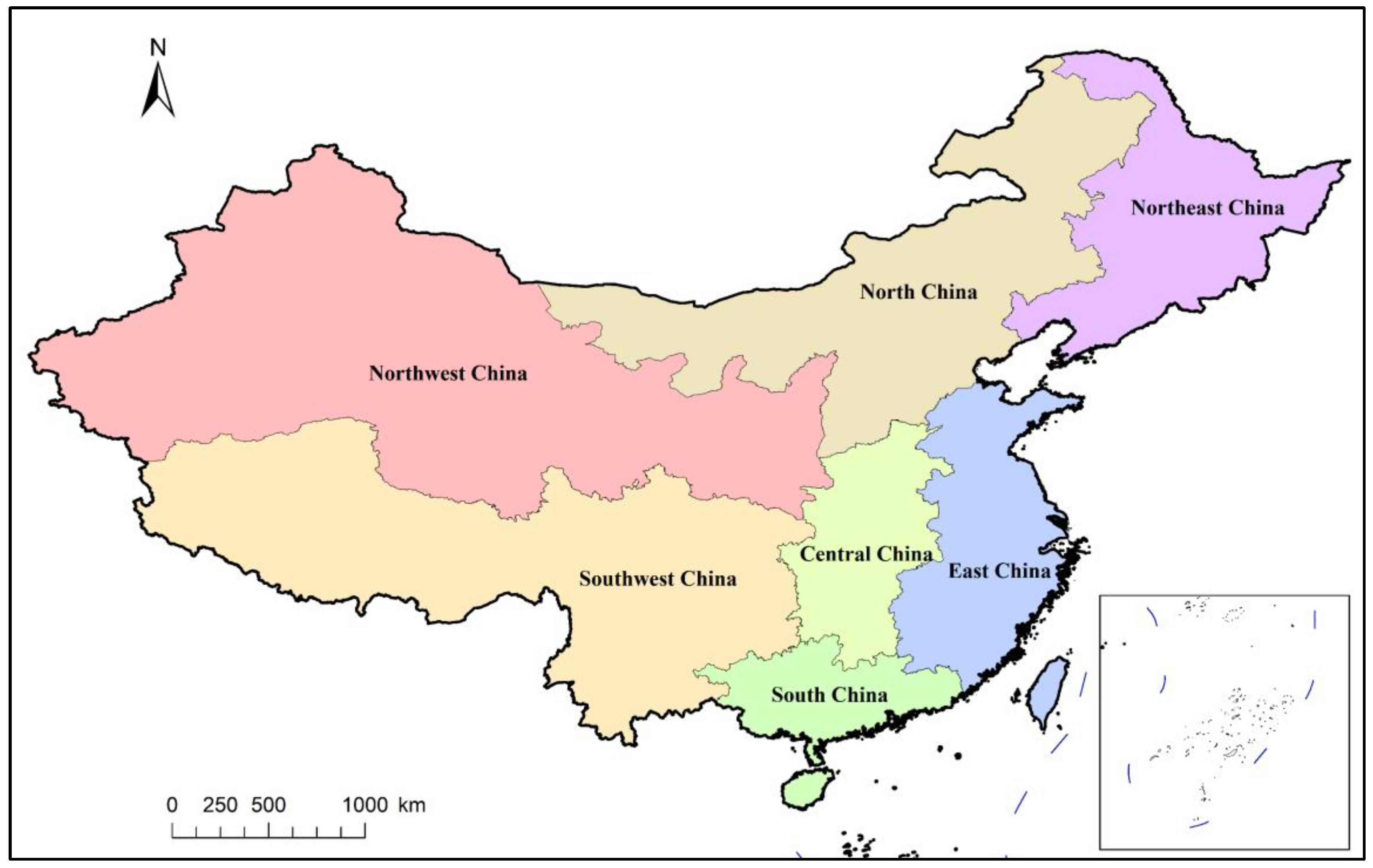
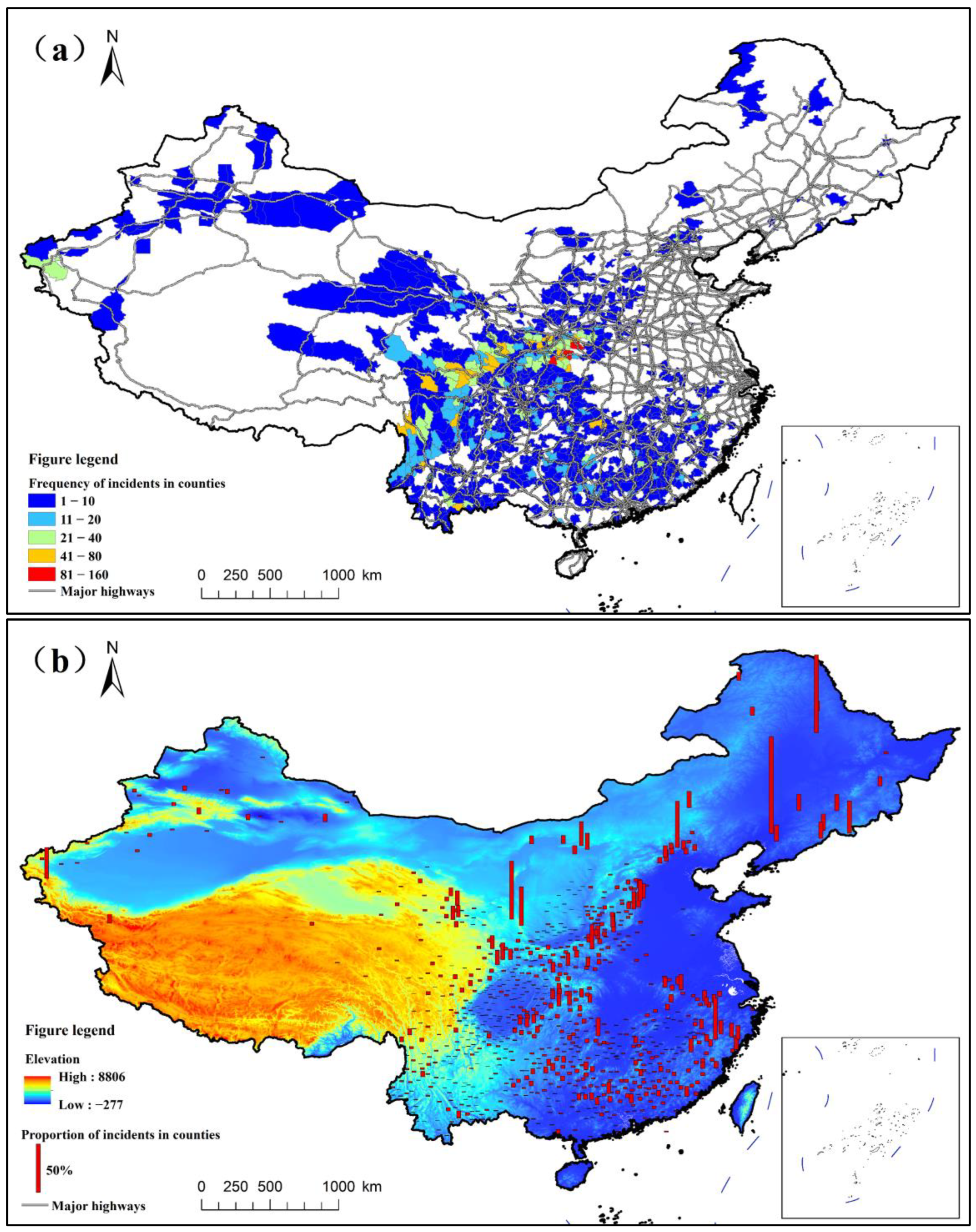


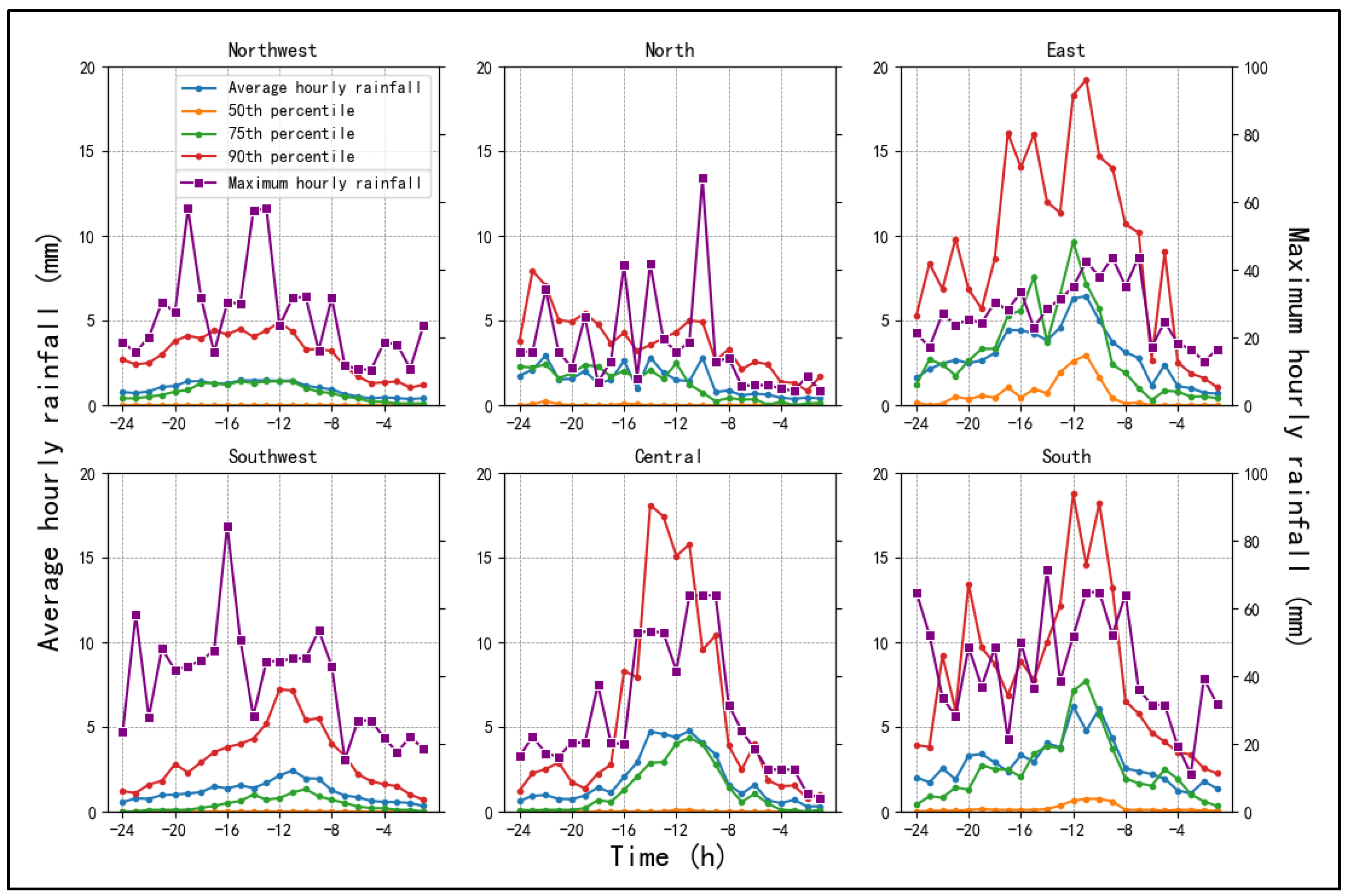

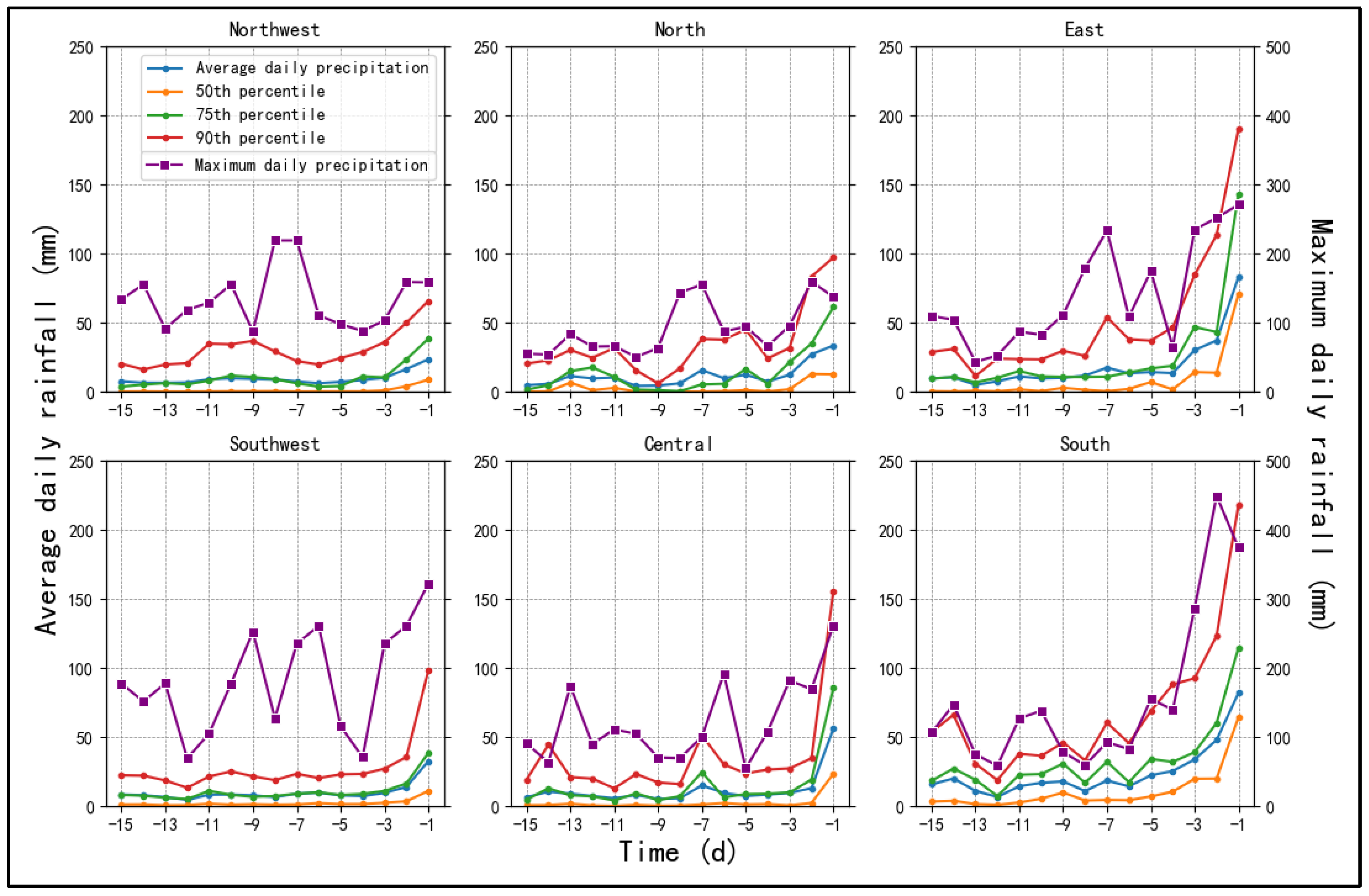
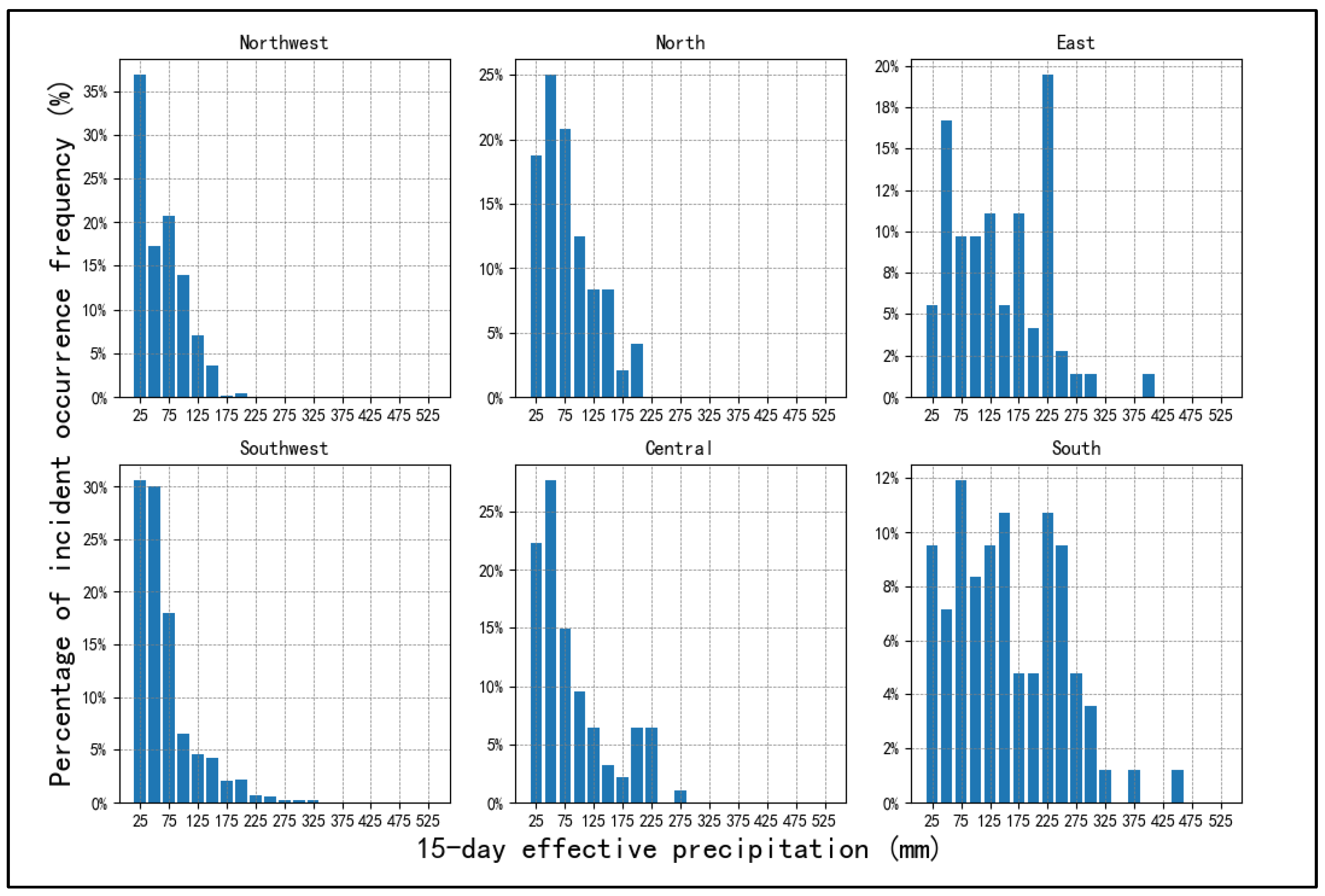
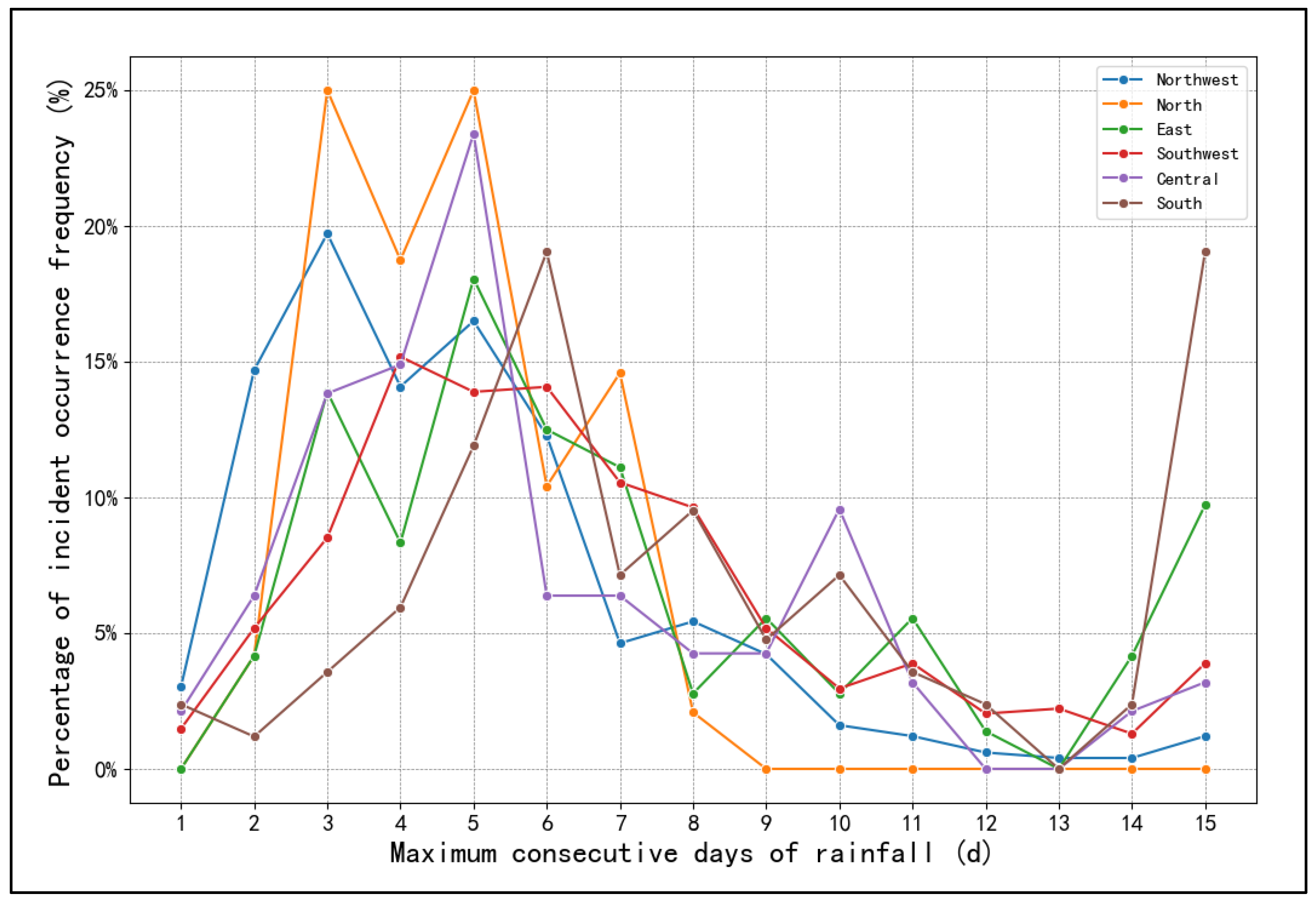
| Precipitation Type | Statistical Period | Region | |||||
|---|---|---|---|---|---|---|---|
| East | Central | Northwest | Southwest | North | South | ||
| Short-term light rain | Past 3 h | 0.7% | 0.4% | 0.5% | 0.5% | 0.5% | 0.7% |
| Past 6 h | 1.6% | 1.1% | 1.3% | 1.2% | 1.3% | 1.5% | |
| Past 12 h | 2.7% | 1.9% | 2.1% | 1.9% | 2.2% | 2.4% | |
| Past 24 h | 3.4% | 2.6% | 2.9% | 2.5% | 3.0% | 2.9% | |
| Short-term moderate rain | Past 3 h | 0.2% | 0.6% | 0.6% | 0.4% | 0.8% | 0.7% |
| Past 6 h | 0.7% | 1.9% | 1.6% | 1.4% | 1.8% | 2.8% | |
| Past 12 h | 3.4% | 5.4% | 4.3% | 3.7% | 4.9% | 5.5% | |
| Past 24 h | 9.4% | 11.0% | 10.3% | 7.7% | 15.5% | 10.3% | |
| Short-term heavy rain | Past 3 h | 0.2% | 0.6% | 0.3% | 0.5% | 0.4% | 0.5% |
| Past 6 h | 0.9% | 1.8% | 0.7% | 1.6% | 2.0% | 1.5% | |
| Past 12 h | 4.5% | 6.6% | 4.4% | 5.8% | 6.7% | 4.5% | |
| Past 24 h | 12.3% | 12.2% | 11.9% | 11.3% | 16.0% | 10.3% | |
| Short-term torrential rain | Past 3 h | 0.7% | 0.5% | 0.4% | 0.7% | 0.4% | 0.3% |
| Past 6 h | 2.0% | 2.3% | 0.8% | 1.4% | 0.4% | 1.2% | |
| Past 12 h | 9.5% | 12.0% | 5.6% | 7.9% | 2.5% | 7.2% | |
| Past 24 h | 20.2% | 22.4% | 15.5% | 16.3% | 12.2% | 12.9% | |
| Short-term downpours and above | Past 3 h | 0.0% | 0.0% | 0.0% | 0.1% | 0.0% | 0.6% |
| Past 6 h | 1.3% | 0.0% | 0.0% | 0.9% | 0.0% | 1.5% | |
| Past 12 h | 10.2% | 9.9% | 1.3% | 5.7% | 1.7% | 7.4% | |
| Past 24 h | 21.3% | 21.1% | 5.2% | 11.0% | 7.8% | 16.0% | |
| Light rain | Past 1 day | 1.8% | 2.0% | 3.1% | 2.6% | 3.2% | 1.9% |
| Past 3 days | 7.8% | 9.2% | 10.2% | 9.2% | 9.3% | 6.6% | |
| Past 3 days | 14.7% | 17.8% | 16.8% | 16.6% | 16.1% | 14.1% | |
| Past 3 days | 22.6% | 25.2% | 23.7% | 23.8% | 23.7% | 22.3% | |
| Moderate rain | Past 1 day | 5.7% | 3.2% | 4.9% | 4.5% | 3.7% | 3.3% |
| Past 3 days | 17.2% | 14.7% | 15.5% | 13.3% | 17.2% | 14.5% | |
| Past 3 days | 28.4% | 22.2% | 25.3% | 21.0% | 25.4% | 21.2% | |
| Past 3 days | 36.0% | 27.4% | 32.5% | 29.7% | 29.9% | 27.6% | |
| Heavy rain | Past 1 day | 2.2% | 6.0% | 10.0% | 9.1% | 6.8% | 2.6% |
| Past 3 days | 11.4% | 14.3% | 23.0% | 21.4% | 23.9% | 15.4% | |
| Past 3 days | 22.2% | 25.0% | 30.5% | 29.5% | 33.0% | 26.9% | |
| Past 3 days | 27.0% | 38.7% | 36.7% | 35.5% | 43.2% | 35.5% | |
| Torrential rain | Past 1 day | 9.6% | 17.9% | 17.2% | 15.5% | 21.3% | 11.6% |
| Past 3 days | 27.0% | 26.2% | 30.7% | 24.4% | 34.0% | 22.5% | |
| Past 3 days | 33.0% | 31.0% | 38.7% | 31.0% | 46.8% | 34.7% | |
| Past 3 days | 43.5% | 45.2% | 44.1% | 38.5% | 51.1% | 46.2% | |
| Downpours and above | Past 1 day | 45.9% | 67.7% | 19.4% | 41.7% | 26.7% | 35.5% |
| Past 3 days | 70.5% | 77.4% | 38.7% | 53.5% | 53.3% | 61.8% | |
| Past 3 days | 72.1% | 80.6% | 38.7% | 55.1% | 53.3% | 71.1% | |
| Past 3 days | 78.7% | 87.1% | 45.2% | 65.4% | 80.0% | 71.1% | |
| Region | Northwest | North | East | Southwest | Central | South |
|---|---|---|---|---|---|---|
| Mean | 23.5 | 33.9 | 73 | 27.9 | 45 | 70.2 |
| 90% | 65.8 | 78.9 | 178.8 | 82.4 | 120.5 | 168.1 |
| 75% | 37.4 | 53.6 | 142.3 | 39.6 | 67 | 99.3 |
| 50% | 12.5 | 18.8 | 38.8 | 10.2 | 27.8 | 53.6 |
| 25% | 0.1 | 1.4 | 17.7 | 0.9 | 0.3 | 18.6 |
| Region | Northwest | North | East | Southwest | Central | South |
|---|---|---|---|---|---|---|
| Mean | 48.9 | 67.6 | 129.4 | 54.5 | 74 | 148.4 |
| 90% | 103.9 | 126.6 | 217.3 | 126.3 | 181.4 | 261.7 |
| 75% | 75.2 | 97.2 | 201.7 | 69.2 | 103.7 | 218.6 |
| 50% | 44.8 | 57.9 | 122 | 40.1 | 50.9 | 129.8 |
| 25% | 14.8 | 29.2 | 61 | 19.6 | 28.4 | 71.3 |
Disclaimer/Publisher’s Note: The statements, opinions and data contained in all publications are solely those of the individual author(s) and contributor(s) and not of MDPI and/or the editor(s). MDPI and/or the editor(s) disclaim responsibility for any injury to people or property resulting from any ideas, methods, instructions or products referred to in the content. |
© 2024 by the authors. Licensee MDPI, Basel, Switzerland. This article is an open access article distributed under the terms and conditions of the Creative Commons Attribution (CC BY) license (https://creativecommons.org/licenses/by/4.0/).
Share and Cite
Zhang, J.; Tian, H.; Song, J. Exploring the Spatio-Temporal Trends of Geomorphological Incidents Induced by Precipitation on Chinese Highways. Atmosphere 2024, 15, 391. https://doi.org/10.3390/atmos15040391
Zhang J, Tian H, Song J. Exploring the Spatio-Temporal Trends of Geomorphological Incidents Induced by Precipitation on Chinese Highways. Atmosphere. 2024; 15(4):391. https://doi.org/10.3390/atmos15040391
Chicago/Turabian StyleZhang, Jie, Hua Tian, and Jianyang Song. 2024. "Exploring the Spatio-Temporal Trends of Geomorphological Incidents Induced by Precipitation on Chinese Highways" Atmosphere 15, no. 4: 391. https://doi.org/10.3390/atmos15040391




